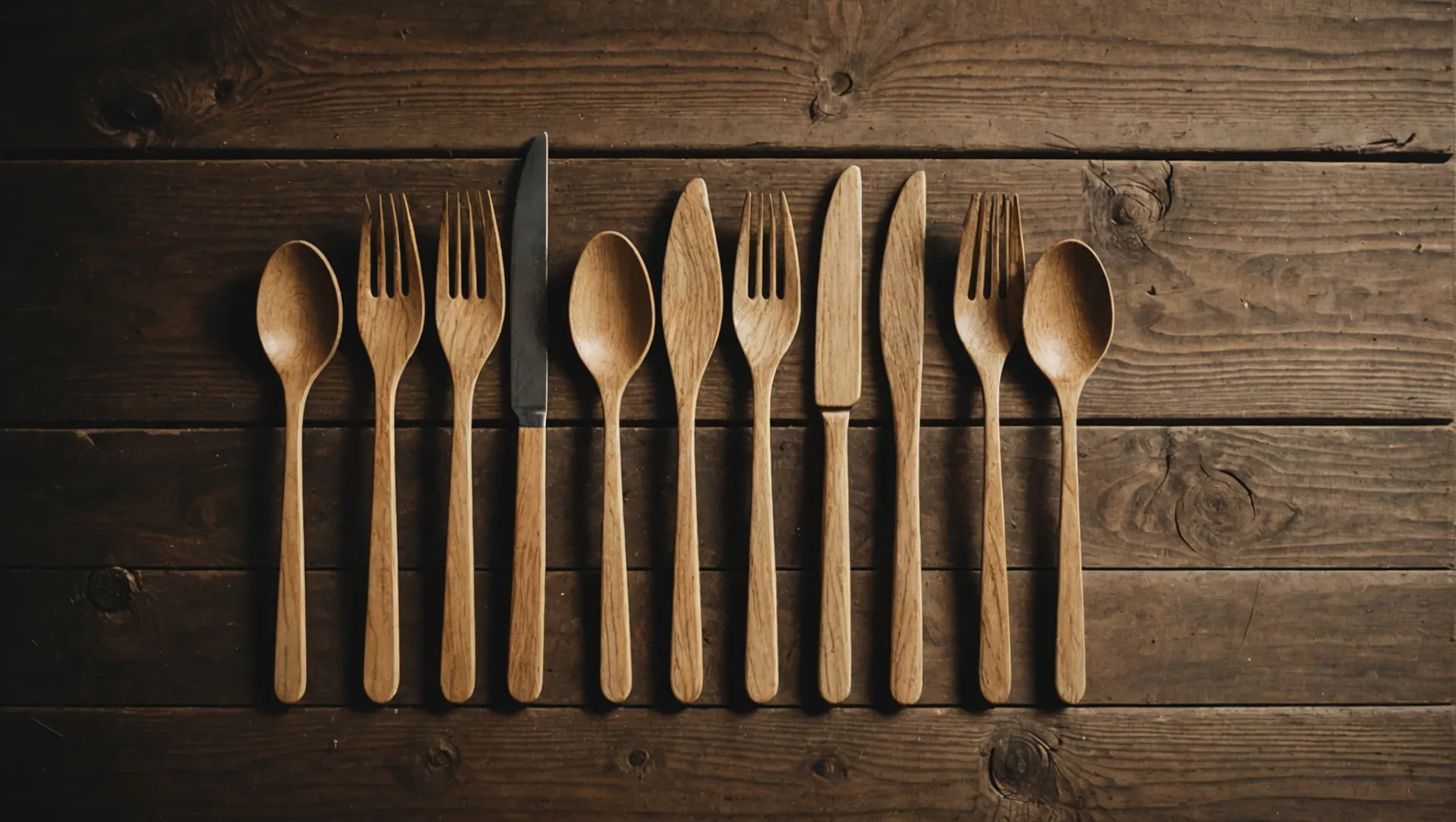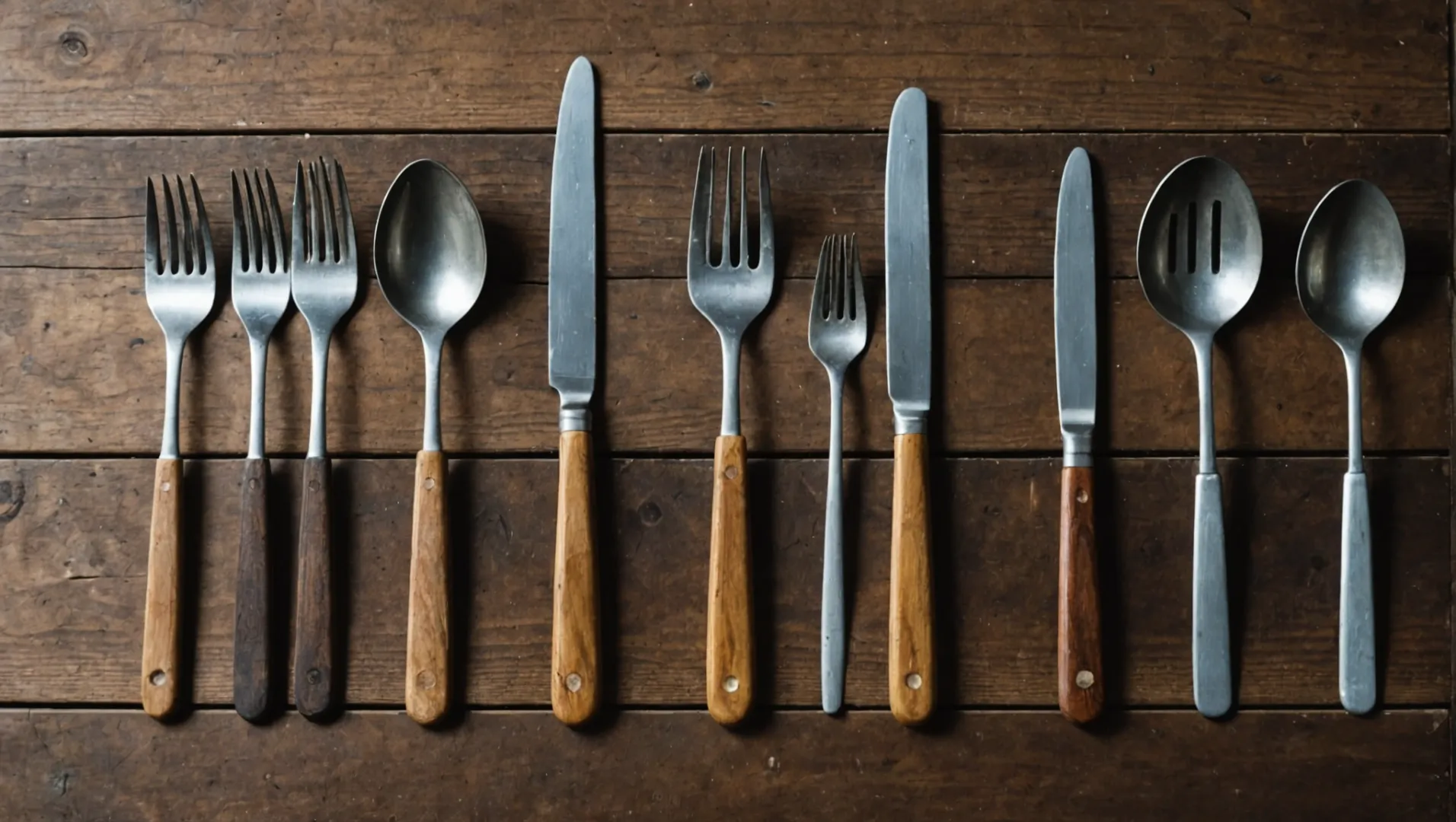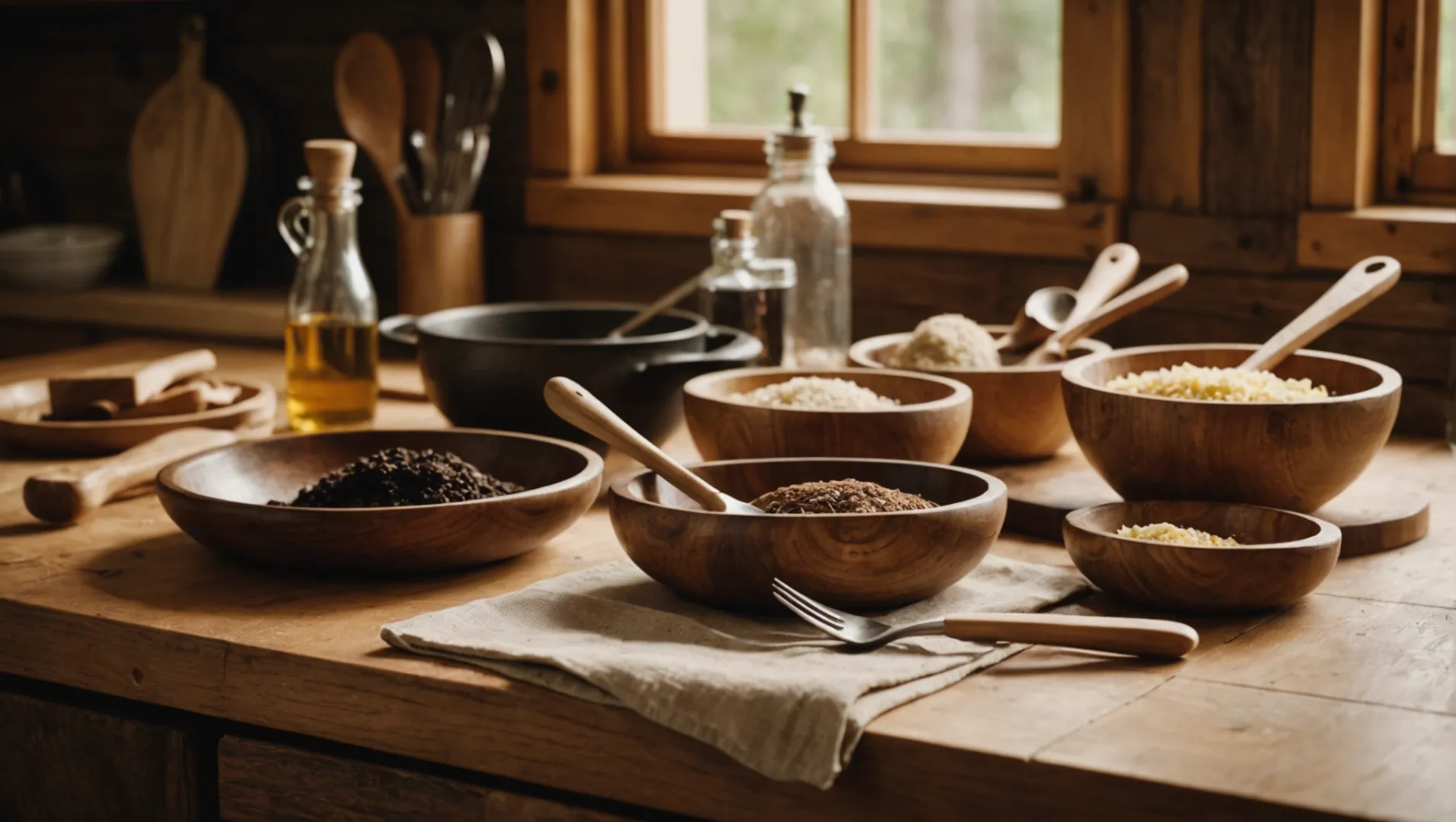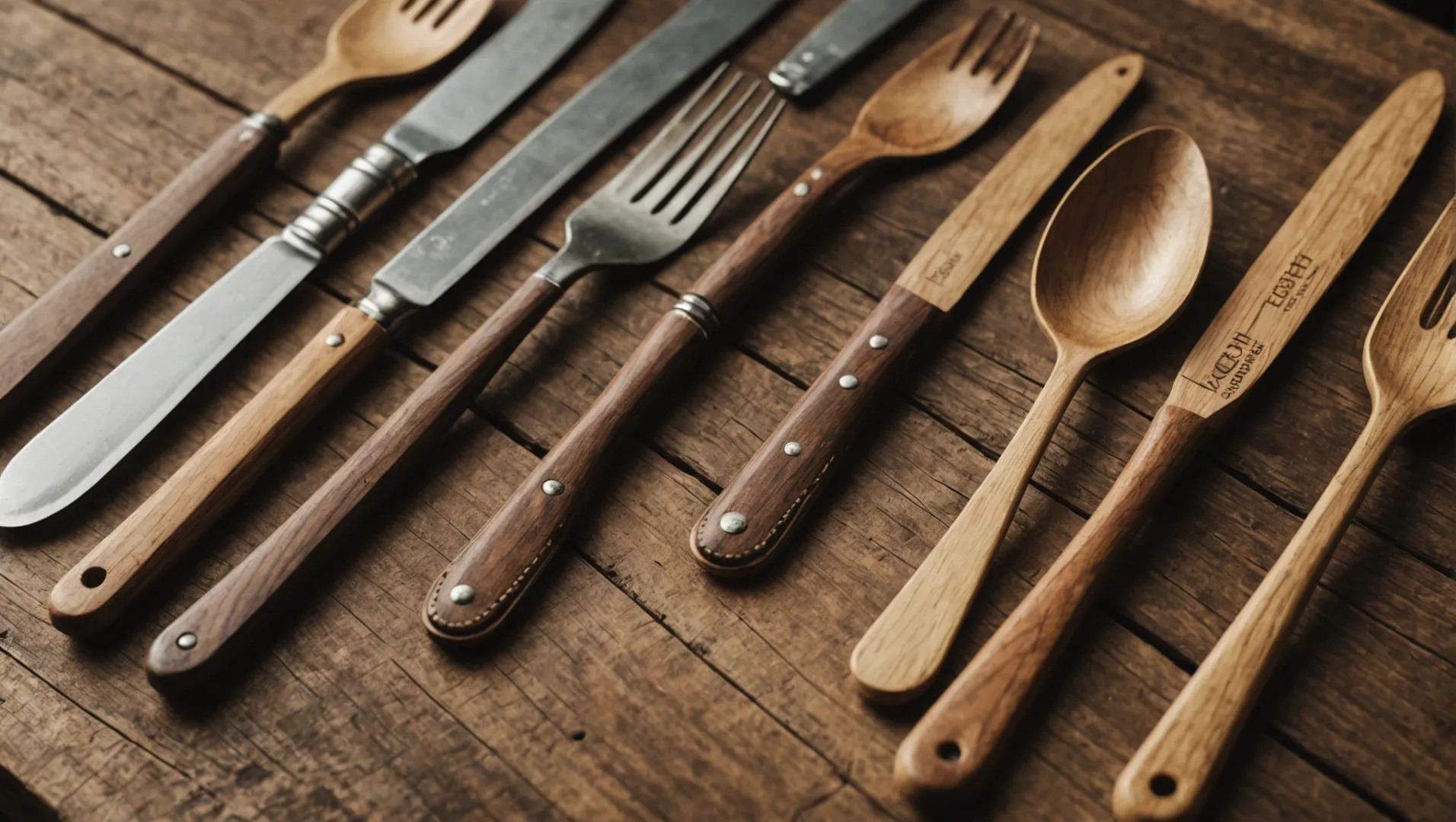
Thinking about ditching plastic cutlery for something more sustainable? Let's dive into what you need to know about wooden alternatives.
Disposable wooden cutlery, while eco-friendly, can have drawbacks such as hygiene concerns due to porosity, durability issues requiring regular maintenance, and the environmental impact of wood sourcing. Understanding these factors is crucial before making a switch.
While wooden cutlery presents some challenges, understanding them fully can guide you in making a sustainable choice that balances environmental benefits with practical use. Let's delve deeper into the specific concerns and how they might impact your decision.
Wooden cutlery is more hygienic than plastic.False
Wood is porous, harboring bacteria if not maintained, unlike plastic.
How Does the Hygiene of Wooden Cutlery Compare to Other Materials?
Is wooden cutlery as hygienic as plastic or metal alternatives? Let's explore this intriguing comparison.
Wooden cutlery, while eco-friendly, requires more care for hygiene compared to plastic or metal due to its porous nature. Regular oiling and proper drying help prevent bacterial growth.

Hygienic Properties of Wooden Cutlery
Wooden cutlery is often praised for its natural aesthetic and sustainability, but how does it measure up in terms of hygiene? The porous nature of wood means it can absorb moisture and harbor bacteria if not maintained properly. Unlike plastic or metal, which can be easily sanitized in dishwashers, wooden utensils demand more attention. Regular oiling1 with food-safe oils like mineral oil or coconut oil helps create a barrier against moisture, reducing the risk of bacterial growth.
Comparing Different Materials
Plastic
Plastic cutlery is non-porous, making it less susceptible to bacterial growth when cleaned properly. However, its environmental impact is significant, as it contributes heavily to landfill waste.
Metal
Metal utensils are highly durable and easy to sanitize in dishwashers, but they are not typically disposable. They offer excellent hygiene but lack the eco-friendliness of wooden options.
Wood
Wooden cutlery shines in eco-friendliness and biodegradability but requires careful maintenance to ensure hygiene. Without regular care, wooden utensils can crack or warp, providing niches for bacteria. However, when well-maintained, they offer a viable alternative to less sustainable materials.
Maintenance for Hygiene
Proper cleaning is essential. Wooden cutlery should be washed by hand with mild soap and warm water, then dried immediately to prevent moisture retention. Avoid soaking them in water or using harsh detergents that might strip away protective coatings. Reapplication of oils2 every few months keeps the wood nourished and less prone to cracking.
Role of Coatings in Hygiene
Natural finishes like beeswax or plant oils not only enhance the aesthetic appeal of wooden cutlery but also serve a functional purpose. These coatings help seal the wood's surface, minimizing moisture absorption and bacterial growth. Over time, these finishes wear off and require reapplication to maintain effectiveness.
The balance between sustainability and practicality is crucial when considering wooden cutlery for everyday use. While it requires more care than plastic or metal options, understanding and implementing the necessary maintenance can help maintain its hygienic properties.
Wooden cutlery is more hygienic than plastic.False
Wood's porous nature can harbor bacteria, unlike non-porous plastic.
Metal cutlery is easier to sanitize than wooden.True
Metal can be easily sanitized in dishwashers, unlike wooden utensils.
What Maintenance Is Required to Ensure the Durability of Wooden Utensils?
Wooden utensils bring a rustic charm to kitchens, but their longevity depends on proper care.
To ensure the durability of wooden utensils, regular maintenance is essential. This includes hand washing with mild soap, immediate drying, and periodic oiling with food-safe oils like mineral or coconut oil to prevent cracking and warping.

Why Proper Cleaning is Crucial
The first step in maintaining wooden utensils is proper cleaning. Unlike metal or plastic, wooden utensils should never be soaked in water or put in the dishwasher, as this can cause swelling and cracking. Instead, wash them by hand using mild soap and warm water. Immediately dry them with a soft towel to prevent moisture absorption.
The Role of Oiling
Oiling is an essential maintenance step that helps keep wooden utensils in top shape. Regular application of food-safe oils such as mineral or coconut oil keeps the wood hydrated and less prone to cracking. It also enhances the utensil's natural beauty. A good rule of thumb is to re-oil your utensils every few weeks or whenever they start to look dry.
Avoiding Extreme Temperatures
Wooden utensils should not be exposed to extreme temperatures. High heat can dry out the wood, leading to cracks, while cold can cause it to become brittle. Avoid leaving wooden utensils near stove tops or open flames, and never use them in the microwave.
Storing Wooden Utensils Correctly
Proper storage is just as important as cleaning and oiling. Store wooden utensils in a dry place, away from direct sunlight which can cause discoloration and warping. It's best to store them upright in a utensil holder or lay them flat in a drawer.
Regular Inspection and Care
Regularly inspect your utensils for signs of wear and tear, such as splinters or cracks. If any rough spots appear, gently sand them down with fine-grit sandpaper. Following this with a thorough wash and a fresh coat of oil will keep your utensils smooth and safe for use.
For more on eco-friendly practices in the kitchen, consider checking out resources on sustainable kitchen tools3.
By implementing these care strategies, not only do you prolong the life of your wooden utensils, but you also ensure they remain a sustainable and hygienic choice for your culinary needs.
Wooden utensils should be soaked in water for cleaning.False
Soaking wooden utensils can cause swelling and cracking.
Regular oiling prevents wooden utensils from cracking.True
Oiling keeps the wood hydrated, reducing the risk of cracks.
How Does the Environmental Impact of Wood Sourcing Affect Sustainability?
The journey from forest to fork influences the eco-footprint of wooden cutlery. Let's explore how.
Wood sourcing impacts sustainability by determining the ecological footprint of wooden products. Sustainable practices like responsible harvesting and eco-certifications ensure minimal environmental impact and promote forest regeneration.

The Role of Responsible Harvesting
Sustainability in wood sourcing hinges on responsible harvesting practices. This involves selecting trees that are mature and ready for harvest without jeopardizing the forest's health or biodiversity. Sustainable forestry4 ensures continuous tree growth and habitat preservation, mitigating negative impacts on ecosystems.
| Table: Comparison of Harvesting Practices | Method | Impact on Biodiversity | Long-term Forest Health |
|---|---|---|---|
| Clear-cutting | High negative impact | Detrimental | |
| Selective logging | Low impact | Promotes regeneration |
The Importance of Eco-Certifications
Eco-certifications, such as FSC (Forest Stewardship Council), validate that wood comes from responsibly managed forests. These certifications not only assure consumers of sustainable practices but also enhance a brand's market credibility. Certified wood sourcing5 is crucial for maintaining ecological balance.
Life Cycle Assessment (LCA) Benefits
Conducting a Life Cycle Assessment provides a comprehensive view of the environmental impact from production to disposal. LCA evaluates resource usage, energy consumption, and waste generation, highlighting areas for improvement. Companies utilizing LCA can adjust processes to reduce their ecological footprint, making wooden cutlery a more sustainable choice.
Transparency and Traceability in Supply Chains
Transparency in wood sourcing is increasingly demanded by consumers and regulatory bodies. Technologies like blockchain can track the journey of wood from forests to factories, ensuring legal and sustainable harvesting. Supply chain transparency6 fosters consumer trust and aligns with eco-friendly market trends.
The impact of wood sourcing on sustainability is multifaceted, involving ecological responsibility, certification standards, and transparent supply chains. Understanding these elements can guide more informed choices about wooden products.
Eco-certifications ensure wood is sustainably sourced.True
Eco-certifications verify that wood comes from responsibly managed forests.
Clear-cutting promotes forest regeneration.False
Clear-cutting has a high negative impact on biodiversity and forest health.
Can Certifications Enhance the Credibility of Wooden Cutlery?
In a world increasingly focused on sustainability, how can certifications bolster the credibility of wooden cutlery brands?
Certifications like FDA, LFGB, and FSC ensure wooden cutlery meets safety and sustainability standards, enhancing consumer trust. These certifications verify that products are safe for food contact and sourced responsibly, crucial for brands targeting eco-conscious markets.

Understanding Key Certifications
Certifications play a pivotal role in establishing the credibility of wooden cutlery7. They act as a guarantee of quality, safety, and sustainability, addressing consumer concerns about product origins and manufacturing processes.
-
FDA and LFGB Certification: These certifications assure consumers that the wooden utensils are safe for food contact. The Food and Drug Administration (FDA) in the United States and the Lebensmittel- und Futtermittelgesetzbuch (LFGB) in Germany provide guidelines that manufacturers must meet to ensure their products do not pose health risks.
-
FSC Certification: The Forest Stewardship Council (FSC) certification is critical for demonstrating sustainable sourcing. It confirms that the wood used in cutlery comes from responsibly managed forests that provide environmental, social, and economic benefits.
The Role of Life Cycle Analysis
Life Cycle Analysis (LCA) offers a comprehensive method to measure the environmental impact of wooden cutlery throughout its production and disposal phases. By conducting an LCA, companies can:
- Identify Areas for Improvement: Understand energy consumption and resource use, allowing for more efficient production processes.
- Enhance Market Appeal: Offer transparent data to consumers about the environmental footprint of their products.
Leveraging Technology for Transparency
Blockchain technology8 is emerging as a powerful tool in ensuring traceability in the supply chain. By using blockchain, companies can provide verifiable information on the origin of their materials, ensuring:
- Authenticity: Consumers can trust the source of wood used.
- Sustainability: Ensures materials are harvested legally and sustainably, aligning with consumer expectations.
Competitive Advantage in Eco-Conscious Markets
As global markets become more environmentally aware, companies with certified products often gain a competitive edge. Eco-certifications not only enhance credibility but also align with stringent regulations on single-use plastics, particularly in North America and Europe.
| Certification | Purpose | Benefits |
|---|---|---|
| FDA/LFGB | Ensures safety in food contact | Enhances consumer confidence |
| FSC | Guarantees sustainable sourcing | Supports environmental commitment |
| LCA | Measures environmental impact | Drives operational improvements |
In conclusion, certifications are invaluable in building trust and demonstrating a brand's commitment to sustainability, crucial for engaging with today's eco-conscious consumers.
FSC certification guarantees sustainable sourcing of wood.True
FSC ensures wood is sourced from responsibly managed forests.
FDA certification is not necessary for wooden cutlery safety.False
FDA certification assures wooden cutlery is safe for food contact.
Conclusion
In summary, wooden cutlery requires thoughtful consideration regarding maintenance and sourcing. By choosing certified, responsibly sourced products, you can make an eco-friendly choice.
-
Discover effective oils that enhance hygiene and longevity of wooden cutlery.: Mineral oil has long been the go-to for oiling wood, but some people don't want to buy petroleum products, as they could be possible carcinogens. ↩
-
Learn the correct method to oil wooden cutlery for better hygiene.: Apply the oil: Using a clean, soft cloth or paper towel, apply the oil in an even layer over the wood. Let it soak in: Leave the oil to soak in, overnight if ... ↩
-
Discover more eco-friendly options for maintaining a green kitchen.: Enter your kitchen and be surrounded by a warm, sustainable aura. Replacing your plastic wrap and single-use sandwich baggies with quality (and Earth ... ↩
-
Learn how sustainable forestry preserves ecosystems while supporting wood production.: Sustainable forestry—a cycle of growing, harvesting, and replanting while protecting water, wildlife, and recreation—generates forest products which provide an ... ↩
-
Discover how FSC certification ensures sustainable and ethical wood sourcing.: Environmental Protection - FSC's forest management standards expand protection of water quality, prohibit harvest of rare old-growth forest, ... ↩
-
Explore how blockchain technology enhances transparency and trust in supply chains.: Using blockchain can improve both supply chain transparency and traceability as well as reduce administrative costs. ↩
-
Discover essential certifications ensuring quality and safety in wooden cutlery.: An essential guide to wooden kitchen product regulations in the EU, covering FCM regulations, REACH, EN standards, labeling, and more. 1 0. ↩
-
Explore how blockchain verifies sustainable sourcing in supply chains.: Technologies like blockchain can help offset such detrimental effects by ensuring the authenticity of information and transparency during upstream transactions. ↩

